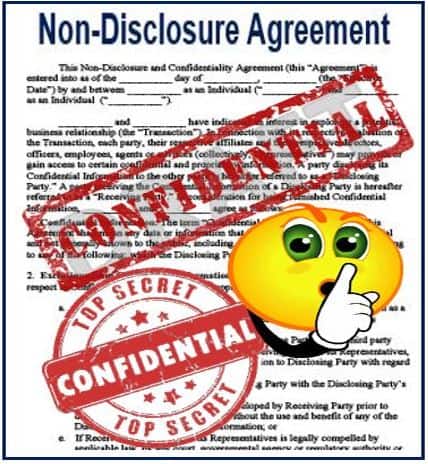A non-disclosure agreement, also called a confidentiality agreement, is a contract between an individual and a company or organization in which either or both parties promise to keep certain things or everything that is discussed and presented confidential. It allows organizations to present their intellectual property with other parties, whose input they need, without placing that information at risk.
You might need to tell people about your idea or your commercial enterprise to get advice, this could be to insurance brokers, financial advisors, banks, accountants, business coaches or a marketing agency. You should use a non-disclosure (NDA) agreement with them.
You might also want confidentiality when talking to investors, stockists or manufacturers. NDAs can cover business plans, customer and prospect lists, chemical and mathematical formulae, technical designs and drawings, and trade secrets.

Information is defined as confidential or a trade secret when it is not known in the public domain. Its value is lost when it is no longer a secret.
You should not assume that any conversation with an advisor is automatically confidential. A non-disclosure agreement is a legally-binding contract. It sets out how which the ideas or information should be shared in confidence.
When is a non-disclosure agreement advisable
– Receiving services from a firm that needs access to sensitive information about your company in order to operate on your behalf.
– Presenting a business idea or invention to an investor, potential partner, advisor or distributor.
– For specific employees who have access to proprietary and confidential information.
– Sharing marketing, financial and other data with a company or individual that is planning to acquire your company. We call this process of checking out the target company ‘due diligence’.

Your non-disclosure agreement
It is up to you what your non-disclosure agreement covers – just information that is recorded marked ‘confidential’, or everything that is shared in presentations or meetings.
Britain’s Intellectual Property Office says that a good contract restricts the use of information or ideas to a specifically permitted purpose. This could be the discussion of a joint venture or the evaluation of your project or idea.
The permitted purpose of your NDA can always be widened later. It won’t be possible to narrow the NDA’s restriction on the use of your information or ideas at a later date.
Britain’s Intellectual Property Office writes:
“You should be realistic. The person you are talking to might need to share your information with others. This could be their employees or professional advisors. They may also need to copy your information for this purpose. Make sure that these disclosures to employees and professional advisers are made in confidence.”
You should consider how long you want the confidentiality to last. In most cases, a non-disclosure agreements is limited from three to five years. After its expiry date, the other parties will be able to disclose your ideas or information.
You can, if you want, keep some information confidential forever, such as customer lists, personal information about the people involved in a project, and non-patentable know-how.
Make it clear in the non-disclosure agreement that you retain the intellectual property rights, possible patents or copyright.
Make sure that any information you want to protect cannot be construed as being in the public domain. The moment you present your product, tell another person about an idea or write about it, it is generally not considered as confidential any more.

If your information is ultra-sensitive and your NDA is not specific enough, it might not provide enough protection. Perhaps you should consider using a legal expert to draw up a bespoke contract. Bespoke means made according to your needs.
A non-disclosure agreement probably does not make sense for a start-up that is trying to raise funds from venture capitalists, because the majority of venture capital investors refuse to sign NDAs.
Key features of a non-disclosure agreement
An NDA does not have to be complicated and long. The best ones, in fact, rarely run more than a couple of pages long.
The key features of an NDA are:
– The parties involved; who they are.
– Detailed description of what is deemed to be confidential.
– How confidential the receiving party will need to treat the information.
– For how long the NDA will be valid.
One-way or mutual
A non-disclosure agreement can be one way or mutual. If both parties are disclosing sensitive information, a mutual NDA is advisable, if it is only you a one-way NDA would be appropriate.
A one-way NDA may have to be executed as a deed in order to make it enforceable.
If the other party or parties reside in another country, the non-disclosure agreement must state which law governs the agreement – countries have different legal systems. The contract must also state in which courts it can be enforced.
A Precedent Confidentiality Agreement is used when a merger or acquisition is underway, or being attempted.
Non-disclosure agreement advice
As soon as you have signed an NDA you have entered into a world of confidentiality and legally binding contracts. In this environment, you can share ideas with other people while preventing them from passing on this information.
Bear in mind, however, that no matter how perfect your contract is, it is only as good as the party that signs it. If they breach the contract, you have the option of taking them to court. This is usually expensive and very time-consuming.
If you believe the other party is on the verge of breaching the NDA, you should consider getting an injunction – a court order that prevents them from violating the terms of the agreement.
Most lawyers advise against using on-form NDAs (off the shelf). Who knows whether this advice is given for our benefit or their own?
Compound phrases with NDA
From the term NDA, we can make two-word phrases – we call them compound phrases. Here are 9 of them:
NDA Compliance
Refers to adherence to the terms set forth within a non-disclosure agreement.
NDA Breach
A situation where the confidential information covered by an NDA is disclosed in violation of its terms.
NDA Template
A pre-formatted document that serves as a starting point for creating a non-disclosure agreement.
NDA Clause
A specific section or provision within a larger contract that serves as a non-disclosure agreement.
NDA Violation
An act that goes against the terms and conditions of a non-disclosure agreement.
NDA Requirement
A condition that necessitates the use of a non-disclosure agreement.
NDA Signatory
A person or entity who has signed and is legally bound by a non-disclosure agreement.
NDA Terms
The specific conditions and stipulations outlined in a non-disclosure agreement.
NDA Policy
A policy that dictates how non-disclosure agreements should be handled within an organization.
Other languages
Here is the term ‘Non-Disclosure Agreement’ in various other languages:
- Spanish: Acuerdo de Confidencialidad, Contrato de Confidencialidad
- Hindi: गोपनीयता समझौता (Gopaniyata Samjhauta)
- French: Accord de non-divulgation, Contrat de confidentialité
- Arabic: اتفاقية عدم الإفصاح (Ittifaqiyyat ‘adam al-ifsha’), عقد سرية (Aqd Serrah)
- Bengali: গোপনীয়তা চুক্তি (Goponiyota Chukti)
- Russian: Соглашение о неразглашении (Soglashenie o nerazglashenii)
- Portuguese: Acordo de Confidencialidade, Contrato de Não Divulgação
- Indonesian: Perjanjian Kerahasiaan
- Urdu: رازداری معاہدہ (Raazdari Muahida)
- German: Geheimhaltungsvereinbarung, Vertraulichkeitsvereinbarung
- Japanese: 守秘義務契約 (Shuhimitsu gimu keiyaku)
- Swahili: Mkataba wa Kutoa Siri
- Marathi: गोपनीयता करार (Gopniyata Karar)
- Telugu: గోప్యతా ఒప్పందం (Gopyata Oppandam)
- Turkish: Gizlilik Sözleşmesi
- Korean: 비밀 유지 계약 (Bimil Yuji Gyeyak)
- Tamil: ரகசிய ஒப்பந்தம் (Ragasiya Oppandham)
- Vietnamese: Thỏa thuận bảo mật
- Italian: Accordo di riservatezza, Contratto di non divulgazione
- Gujarati: ગોપનીયતા કરાર (Gopaniyata Karar)
- Farsi: قرارداد عدم افشا (Gharardad-e Adam-e Eshaa)
- Bhojpuri: गोपनीयता समझौता (Gopaniyata Samjhauta)
- Hakka: 秘密协议 (Bi-miêu hye-yì)
- Mandarin Chinese: 保密协议 (Bǎomì xiéyì)
- Cantonese Chinese: 保密協議 (Bou2 Mat6 Hap6 Ji5)
- Jin Chinese: 保密协议 (Bǎomì xiéyì)
- Southern Min: 保密协议 (Pó͘-bí hiap-oē)
- Kannada: ಗೌಪ್ಯತಾ ಒಪ್ಪಂದ (Goupyatha Oppanda)
